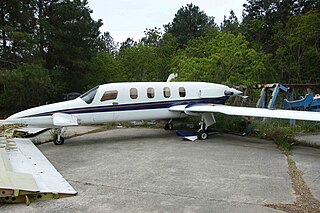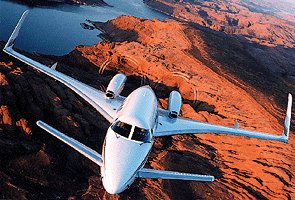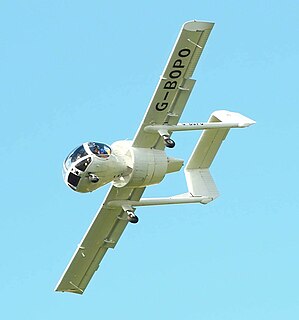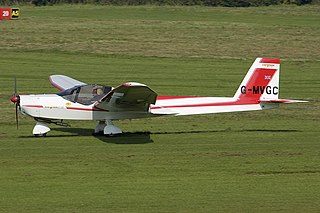
The AASI Jetcruzer was an American single turboprop light civil transport made by Advanced Aerodynamics and Structures Inc. The Jetcruzer had an unusual configuration, with a single turboprop engine driving a pusher propeller, a prominent canard, and fins mounted at the ends of its swept wings. The plane has seating for up to six people including the pilot. The Jetcruzer is noteworthy for being the first aircraft to have achieved a spin resistance certification from the United States FAA.

The Beechcraft Starship is a twin-turboprop six- to eight-passenger pressurized business aircraft produced by Beech Aircraft Corporation.

The Pilatus PC-9 is a single-engine, low-wing tandem-seat turboprop training aircraft manufactured by Pilatus Aircraft of Switzerland. Designed as a more powerful evolution of the Pilatus PC-7, the PC-9's first flight was made in May 1984 after which certification was achieved in September 1985. After this, the first production orders for the type were received from the Royal Saudi Air Force, with deliveries commencing in 1985. Since then, more than 250 airframes have been produced across five different variants and the type is employed by a number of military and civilian operators around the world, including the Swiss Air Force, the Croatian Air Force, and the Royal Thai Air Force.

The HAL HJT-36 Sitara is a subsonic intermediate jet trainer aircraft developed by Hindustan Aeronautics Limited (HAL) for the Indian Air Force and the Indian Navy. The HJT-36 will replace the HAL HJT-16 Kiran as the Stage-2 trainer for the two forces.

The IAI Westwind is a business jet initially produced by Aero Commander as the 1121 Jet Commander. Powered by twin GE CJ610 turbojets, it first flew on January 27, 1963 and received its type certification on November 4, 1964, before the first delivery. The program was bought by Israel Aircraft Industries (IAI) in 1968, which stretched it slightly into the 1123 Westwind, and then re-engined it with Garrett TFE731 turbofans into the 1124 Westwind. The 16,800–23,500 lb (7.6–10.7 t) MTOW aircraft can carry up to 8 or 10 passengers, and 442 were produced until 1987.

The LearAvia Lear Fan 2100 was a turboprop business aircraft designed in the 1970s, with unusual configuration. The Lear Fan never entered production.

The Piper PA-31 Navajo is a family of cabin-class, twin-engined aircraft designed and built by Piper Aircraft for the general aviation market, most using Lycoming engines. It was also license-built in a number of Latin American countries. Targeted at small-scale cargo and feeder liner operations and the corporate market, the aircraft was a success. It continues to prove a popular choice, but due to greatly decreased demand across the general aviation sector in the 1980s, production of the PA-31 ceased in 1984.

The Dassault Falcon 20 is a French business jet developed and manufactured by Dassault Aviation. The first business jet developed by the firm, it became the first of a family of business jets to be produced under the same name; of these, both the smaller Falcon 10 and the larger trijet Falcon 50 were direct derivatives of the Falcon 20.

The Edgley EA-7 Optica is a British light aircraft designed for low-speed observation work, and intended as a low-cost alternative to helicopters. The Optica has a loiter speed of 130 km/h and a stall speed of 108 km/h.

The Socata TB 30 Epsilon is a light military trainer aircraft produced by SOCATA. It is a tandem two-seater with a metal airframe. The first prototype flew on 22 December 1979.

The ARV Super2 is a British two-seat, strut-braced, shoulder wing, tricycle landing gear light aircraft designed by Bruce Giddings. Available either factory-built or as a kit, it was intended to be both a cost-effective trainer and an affordable aircraft for private owners. Later called the "Opus", it gained US FAA Light-Sport Aircraft approval in February 2008.

The SyberJet SJ30 is a light business jet built by American company SyberJet Aircraft. In October 1986, Ed Swearingen announced the new design, a 6 to 8 person aircraft powered by two Williams FJ44 turbofans. Initially backed by Gulfstream Aerospace from October 1988, the Jaffe Group took over in September 1989 and the first SJ-30 flew on February 13, 1991 but development halted afterwards. The Taiwan-based Sino Swearingen Aircraft Corporation rescued the program, the jet was stretched by 4.3 ft into the SJ30-2 with a wingspan increased by six feet.

The Gavilán 358 is a Colombian light utility transport aircraft of the 1990s. A high-winged monoplane powered by a piston engine, small numbers of Gaviláns were produced in the late 1990s/early 2000s, some serving with the Colombian Air Force.

Not to be confused with the T-35 Buckaroo. For other uses, see: T35 (disambiguation)

The Avtek 400A was an American prototype turboprop-powered business aircraft developed in the early 1980s. It was of unusual and distinctive configuration: a low-wing monoplane with two pusher engines mounted above the wings, and a large canard mounted atop the forward fuselage. The aircraft's sleek, futuristic design earned it a guest appearance on the Airwolf TV series as the X-400, the plane used by the villain Lou Stappleford in the episode Eagles.

The Robin ATL is a French two-seat light aircraft designed by Avions Robin in the 1980s to meet a need for an economical two-seat aircraft to equip flying clubs. It is a single-engined monoplane with a fixed tricycle undercarriage, conventional control stick, and is, unusually, fitted with a V-tail. Due to the large bubble canopy, visibility is excellent. Its benign flight characteristics, moderate speeds and low fuel consumption, as well as some unique details, like an engine starter button which can only be pressed when the fuel selector switch is open, made the ATL a good trainer.
The Verilite Model 100 Sunbird was a low-cost light aircraft developed in the United States in the 1980s. It was developed by De Vore Aviation, a company that manufactures aircraft components, as a first foray into aircraft manufacturing. When initiated in 1983, the goal of the project was to create a two-seat light aircraft that could be sold for less than $US 20,000. Additionally, it was hoped that the Sunbird operating costs would be half that of a conventional two-seat aircraft. Funding for the project became available in 1985, and the Verilite subsidiary was created to develop the concept. The design was unconventional: a high-wing, strut-braced monoplane with the single engine fitted in pusher configuration at the rear of the wing, and the empennage carried on an aluminum boom. The pilot and a single passenger sat side by side in a fully enclosed cockpit, and fixed, tricycle undercarriage was fitted. Originally simply dubbed the "Affordable Airplane", the name "Sundancer" was chosen as the winner of a public competition, and later changed to "Sunbird".

The Robin R 3000 is a French single-engined light aircraft designed and built by Avions Robin, which entered production in the 1980s.

The AMF Chevvron is a British two-seat microlight aircraft of the 1980s and 90s. It is a single engined mid-winged monoplane with side-by-side seating. 41 were built.
The Grob G 110 was a single-engined two-seat light aircraft, made mainly of glassfibre, which was designed and built by the German manufacturer Grob Aircraft in the early 1980s. Two prototypes were built, with the first example making its maiden flight on 6 February 1982, but development was abandoned after the first prototype crashed later that year.


















